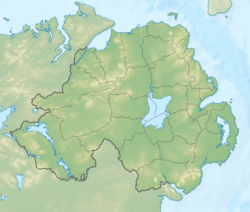Ballygawley bus bombing facts for kids
Quick facts for kids Ballygawley bus bombing |
|
|---|---|
| Part of the Troubles | |
| Location | Near Ballygawley, County Tyrone, Northern Ireland |
| Coordinates | 54°31′42″N 7°12′39″W / 54.52833°N 7.21083°W |
| Date | 20 August 1988 12:30 a.m. |
| Target | British Army personnel |
|
Attack type
|
Roadside bomb |
| Deaths | 8 soldiers |
|
Non-fatal injuries
|
28 soldiers |
| Perpetrator | Provisional IRA |
The Ballygawley bus bombing was a serious attack during a time of conflict in Northern Ireland called the Troubles. It happened on 20 August 1988, when a hidden bomb exploded next to a bus carrying British soldiers. The attack was carried out by the Provisional Irish Republican Army (IRA), a group that wanted Northern Ireland to be part of the Republic of Ireland.
The bombing took place near a town called Ballygawley in County Tyrone. Eight soldiers were killed in the blast, and 28 others were hurt. After this event, the British Army started using helicopters to move its soldiers around County Tyrone to keep them safer.
Contents
What Was the Troubles?
The Troubles was a period of conflict in Northern Ireland that lasted for about 30 years, from the late 1960s to 1998. It was a struggle between people who wanted Northern Ireland to remain part of the United Kingdom (called unionists or loyalists) and those who wanted it to join the Republic of Ireland (called nationalists or republicans).
During this time, groups like the Provisional IRA used violence, including bombings and shootings. The British Army was sent to Northern Ireland to help keep the peace.
Why This Area Was Important
The road near Ballygawley was known as a place where attacks often happened. The IRA had used hidden bombs, called roadside bombs, against British Army vehicles many times since the early 1970s. These attacks were common in rural areas, especially in parts of County Tyrone and County Armagh.
There had been other serious attacks on soldiers in the area before the Ballygawley bombing:
- In 1979, 18 soldiers were killed in an ambush near Warrenpoint.
- In 1981, five soldiers died when their armored vehicle was hit by a bomb.
- In 1983, four soldiers were killed by a landmine near Ballygawley.
- In 1985, the IRA attacked a police station in Ballygawley, killing two officers.
- In June 1988, just two months before this attack, six off-duty soldiers were killed by an IRA bomb in Lisburn.
The Attack on the Bus
On the night of 19 August 1988, a bus was taking 36 British soldiers back to their military base near Omagh. These soldiers were from England and were finishing their time serving in Northern Ireland. They were returning from a short holiday.
Around 12:30 AM on 20 August, as the bus drove along the main road from Ballygawley to Omagh, IRA members set off a hidden bomb. The bomb contained about 200 pounds (90 kg) of a powerful explosive called Semtex. Police believed the bomb was hidden in a vehicle by the road and set off from about 330 yards (300 meters) away.
The explosion was huge. It threw the bus about 30 meters down the road. Soldiers were thrown into nearby fields and hedges. The blast left a crater 6 feet (1.8 meters) deep in the road. Body parts and twisted metal were scattered everywhere.
People who arrived at the scene described finding dead, dying, and injured soldiers. Some of the first people to help were members of a loyalist band who were also traveling by bus.
Eight soldiers died in the attack: Jayson Burfitt (19), Richard Greener (21), Mark Norsworthy (18), Stephen Wilkinson (18), Jason Winter (19), Blair Bishop (19), Alexander Lewis (18), and Peter Bullock (21). This was the largest loss of life for the British Army in a single IRA attack since 1979.
An investigation into the attack found that the road was usually off-limits for military vehicles because of the danger from the IRA. The bus driver, who was also a soldier, said he was directed onto that road by diversion signs. However, police said they had not placed any such signs. The IRA denied placing signs and said military buses often used the road.
What Happened After the Attack
Soon after the bombing, the Provisional IRA said they were responsible. They stated that their Tyrone Brigade carried out the attack. They also said they would continue their fight until Britain left Ireland.
Security forces thought that someone might have told the IRA the bus's route and when it would pass a certain spot. After the attack, the British military decided to start flying their troops by helicopter in East Tyrone to avoid similar attacks.
Tom King, who was the British government's Secretary of State for Northern Ireland at the time, said there was evidence that the explosives used might have come from Libya. Libya was known to have supplied weapons to the IRA.
Two months after the bombing, the British government introduced a new rule called the broadcasting ban. This rule meant that the voices of members of Sinn Féin (a political party linked to the IRA) and IRA members were not allowed to be broadcast on television or radio. Many believe the Ballygawley bombing influenced this decision.
Old government documents, made public in 2019, showed that the attack caused "panic" within the British government. There was also tension between the police (RUC) and the British Army about who was responsible for the security lapse. The British Prime Minister, Margaret Thatcher, told the RUC chief that she would not send British troops to Northern Ireland "in waves to be killed."
See also
- Chronology of Provisional Irish Republican Army actions (1980–1989)
- M62 coach bombing
- Teebane bombing
- The Troubles in Ballygawley


